
Chimney Rock at Catoctin Mountain Park in Maryland / TrailVoice
A Retreat At Catoctin
This lesser-known national park in Maryland contains significant natural beauty, with some presidential history for good measure.
By Kim O'Connell
It’s early spring after a long pandemic winter, and I’m hiking uphill at Catoctin Mountain Park, feeling every step. The wind is high, and tree branches creak and sway ominously all around me. Feeling rusty from too much time indoors, I want to stop and let the wind push me back downhill, but I don’t. Just be like the wind, I think to myself. At the top, I’m rewarded with an expansive view of the sleepy town of Thurmont, Maryland, as a freight train lumbers past in the distance.
A lesser-known unit of the National Park System, Catoctin Mountain Park is a forested, rocky park on one of the northernmost ridges of the Blue Ridge Mountains—the same mountains that form Shenandoah and Great Smoky Mountains national parks. Its name comes from the mountain it's set on: Catoctin Mountain, which actually is a ridge line without any terribly prominent peaks. While the U.S. Senate twice passed bills to rename the place Catoctin Mountain National Recreation Area, the House never considered either.
At only about nine square miles, this park that was added to the National Park System in 1936 doubles in size when taken together with the adjacent Cunningham Falls State Park. Catoctin boasts 25 miles of trails that traverse ridges and offer stunning views, as well as remnants of human habitation, including displays on the traditional making of charcoal and whiskey. Many of the trails are short, but they can be easily combined for a longer and more immersive experience, and universally accessible trails are available, too.
On the day I visit, I start with a gentle round-trip ramble on the Hog Rock trail before connecting with the Blue Ridge Summit Vista trail, a relatively easy hike with one sizable hill that takes me to a series of lichen-covered rock formations and a view of green rolling hills in the distance. From there I walk on towards the Thurmont Vista trail, an uphill climb that rewards hikers with a bench at the top. Although the trees are not fully leafed out, I’m hiking through a diverse second-growth forest of red oaks, birches, maples, and dogwoods.

Fungi is common at Catoctin Mountain Park/Kim O'Connell
After my hike, I drive the park road past a place for which the park is famous, but that most visitors will never see: Camp David, the presidential retreat. Completed in 1938 by the Works Progress Administration, with assistance from the Civilian Conservation Corps, the camp was developed to house federal workers who were tasked with demonstrating that a recreational area could be developed from land that was not farmable. The Catoctin Recreational Demonstration Area, as it was known, was one of 46 RDAs that were created in 24 states, most of which later became state or national parks, including Acadia, Badlands, Hopewell Furnace, and White Sands. In 1954, the park was divided into Catoctin to the north and Cunningham Falls to the south. Three cabin camps from the 1930s are still available for use by park visitors, and the entire park is a designated historic district on the National Register of Historic Places.
Other organizations also used the property, such as the Maryland League for Crippled Children (now known as The Children’s League), before President Franklin Roosevelt considered renovating it as a presidential retreat. Roosevelt had been invited to use the retreat used by Herbert Hoover within Shenandoah National Park (now known to park visitors as Camp Hoover or Rapidan Camp), but found the trails too rocky and difficult to navigate for his wheelchair. Thus he turned his attention to revamping the retreat at Catoctin near the end of his long presidency, calling it Shangri-La. In the 1950s, President Eisenhower rechristened the retreat in honor of his son David, and the name stuck.
Every U.S. president since Roosevelt has used the retreat at Catoctin for rejuvenation and work. According to Michael Giorgione, author of the book Inside Camp David, Ronald Reagan and Richard Nixon were among the retreat’s most frequent presidential visitors, at 189 and 160 visits, respectively, while President Trump used it the least (15 visits) of any president since Harry Truman (10). Since January, President Biden has already visited Camp David at least three times. In February, Biden’s granddaughter Naomi posted photos of the president wearing a tan “Camp David” ballcap.
“The days I liked best,” Reagan once said, “were those Fridays when I could break away a little early…and take off for Camp David.”

FDR and Winston Churchill at Catoctin / FDR Presidential Library
Often, presidents have done far more than unwind at the retreat. In 1978, representing the culmination of nearly two weeks of negotiations, President Carter oversaw what became known as the “Camp David Accords” between Egyptian President Anwar Sadat and Israeli Prime Minister Menachem Begin, and presidents have entertained foreign presidents, prime ministers, and other world leaders there as well. President Obama hosted the G8 Summit in the camp’s Laurel Cabin in 2012, in which world leaders sat around a cozy round table in a room flanked by an antique sideboard, as if they were about to play cards.
Camp David’s main lodges and cabins resemble a typical cabin retreat, with wood siding and stone accent walls. Inside are plush sofas, fireplaces, and wood paneling. Although the National Park Service doesn’t advertise the camp’s location, it’s obvious once you’re in the park. Along one section of the park road, a large perimeter of forest is posted with “no trespassing” and “no photos allowed” signs. When the president is in residence, most of the park road and many of the park’s trails are closed. Curious visitors frequently slow their vehicles as they pass by this historic but still mysterious section of the park.
“The turnoff,” Giorgione writes in his book, “is a crack in the almost seamless landscape….It can feel, on a dark winter afternoon, as if the nearest human is a thousand miles away.”
It still feels like one of the park system’s best-kept secrets—on the day of my recent hike, I passed only two other hikers—but it may not stay that way for long. Catoctin is now the focus of a major planning effort to enhance the park’s trail system and visitor experience in a way that best protects the park’s natural and cultural environment going forward, in the face of increased visitation. In 2020, the park surpassed half a million visitors, one of its highest recorded visitation records in recent history.
The new plan, which just completed an initial public comment period, would increase vehicular and pedestrian access, open up new areas of the park, and better connect trails both inside and outside the park, such as the Appalachian Trail.
“The park has not in 80 years really taken a comprehensive look at its trails,” said Superintendent Rick Slade in a public meeting in March. “We thought it was high time that we not just look at existing trails and their conditions…but also look at potential additions of trails that might be beneficial to visitors.”

Lichen-covered rock at Catoctin Mountain Park / Kim O'Connell
Support National Parks Traveler
National Parks Traveler is a small, editorially independent 501(c)(3) nonprofit media organization. The Traveler is not part of the federal government nor a corporate subsidiary. Your support helps ensure the Traveler's news and feature coverage of national parks and protected areas endures.
EIN: 26-2378789
A copy of National Parks Traveler's financial statements may be obtained by sending a stamped, self-addressed envelope to: National Parks Traveler, P.O. Box 980452, Park City, Utah 84098. National Parks Traveler was formed in the state of Utah for the purpose of informing and educating about national parks and protected areas.
Residents of the following states may obtain a copy of our financial and additional information as stated below:
- Florida: A COPY OF THE OFFICIAL REGISTRATION AND FINANCIAL INFORMATION FOR NATIONAL PARKS TRAVELER, (REGISTRATION NO. CH 51659), MAY BE OBTAINED FROM THE DIVISION OF CONSUMER SERVICES BY CALLING 800-435-7352 OR VISITING THEIR WEBSITE WWW.FRESHFROMFLORIDA.COM. REGISTRATION DOES NOT IMPLY ENDORSEMENT, APPROVAL, OR RECOMMENDATION BY THE STATE.
- Georgia: A full and fair description of the programs and financial statement summary of National Parks Traveler is available upon request at the office and phone number indicated above.
- Maryland: Documents and information submitted under the Maryland Solicitations Act are also available, for the cost of postage and copies, from the Secretary of State, State House, Annapolis, MD 21401 (410-974-5534).
- North Carolina: Financial information about this organization and a copy of its license are available from the State Solicitation Licensing Branch at 888-830-4989 or 919-807-2214. The license is not an endorsement by the State.
- Pennsylvania: The official registration and financial information of National Parks Traveler may be obtained from the Pennsylvania Department of State by calling 800-732-0999. Registration does not imply endorsement.
- Virginia: Financial statements are available from the Virginia Department of Agriculture and Consumer Services, 102 Governor Street, Richmond, Virginia 23219.
- Washington: National Parks Traveler is registered with Washington State’s Charities Program as required by law and additional information is available by calling 800-332-4483 or visiting www.sos.wa.gov/charities, or on file at Charities Division, Office of the Secretary of State, State of Washington, Olympia, WA 98504.

Comments
Nice article about a great national park. One note, David was Ike's grandson. Thank you.
Thanks for the article. We've been spending part of our weekends at the NPS treasures to the south, e.g., C&O Canal, Antietam, The AT, etc. This weekend, we'll head to Catoctin.